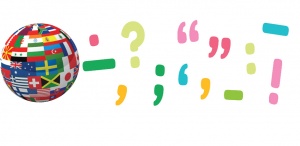Language/Multiple-languages/Grammar/Punctuation-of-many-languages
Marks
Most Common
| Vai | Bamum | Latin | Greek | Cyrillic
Georgian Hebrew |
Armenian | Ge'ez | Arabic | Devanagari | Bengali
Telugu Tamil Gujarati Gurmukhi Malayalam Kannada Oriya |
Sinhala | Thai | Chinese | Korean | Japanese | |
|---|---|---|---|---|---|---|---|---|---|---|---|---|---|---|---|
| comma | ꘍ | ꛵ | , | , | , | , | ፣ | ،
common ⹁ Sindhi |
, | , | , | (none) | , | ,
horizontal 、 vertical |
、 |
| period | ꘎ | ꛳ | . | . | . | ։ | ። | .
common ۔ Urdu |
।
common . Marathi |
।
common . alternative |
.
new ෴ old |
(space) | 。 | . | 。 |
| question mark | ꘏ | ꛷ | ?
commo ¿...? Spanish |
; | ? | ՞ | ፧ | ؟ | ? | ? | ? | ? | ? | ? | (period as formal)
? informal |
| exclamation mark | ꘎꘎ | ! | !
common ¡...! Spanish |
! | ! | ՜ | ! | ! | ! | ! | ! | ! | ! | ! | ! |
| parentheses | ( ) | ( ) | ( ) | ( ) | ( ) | ( ) | ( ) | ( ) | ( ) | ( ) | ( ) | ( ) | () | ( ) | () |
| colon | : | ꛴ | : | : | : | ․ | ፥ | : | : | : | : | : | : | : | : |
| semicolon | ; | ꛶ | ; | ‧ | ; | ; | ፤ | ؛ | ; | ; | ; | ; | ; | ; | ; |
Note:
- Puctuation in Japanese and Chinese are full-width
- Some symbols look like semicolon and colon in Latin script, but they have different codes in computers.
Quotation marks
Some of them have alternatives
| language | primary | secondary | spacing |
|---|---|---|---|
| English, United Kindom
Scottish Gaelic Welsh |
‘…’ | “…” | English: 1–2 pt
Welsh: 1–2 pt |
| Afrikaans
Chinese, China English, United States English, Canada Esperanto Filipino Hindi Indonesian Irish Interlingua Maltese Portuguese, Brazil Thai |
“…” | ‘…’ | English: 1–2 pt
Chinese: fullwidth Irish: 1–2 pt |
| Lao
Vietnamese |
“…” | ||
| Finnish
Swedish |
”…” | ’…’ | |
| Bosnian | ”…”
„…” |
’…’ | |
| Dutch
Hebrew |
„…” | ‚…’ | |
| Serbian | „…” | ’…’ | |
| Croatian | „…” | ‘…’ | |
| Polish | „…” | «…»
»…« |
|
| Romanian | „…” | «…» | none |
| Hungarian | „…” | »…« | |
| Czech
German Icelandic Slovak Slovene Sorbian |
„…“ | ‚…‘ | |
| Bulgarian | „…“ | ’…’
‘…’ |
|
| Macedonian | „…“ | ’…‘ | |
| Albanian | „…“ | ‘…’ | |
| Estonian
Georgian Lithuanian |
„…“ | Georgian: none | |
| Amharic
Azerbaijani Basque French, Switzerland German, Switzerland Italian, Switzerland Romansh Tigrinya Turkish |
«…» | Arabic: optional | |
| French | « … » | “…”
« … » |
¼ em |
| Belarusian
Catalan Greek Italian Occitan Portuguese, Portugal Spanish |
«…» | “…” | Catalan: none |
| Russian
Ukrainian Uzbek |
«…» | „…“ | Russian: none
Ukranian: none |
| Norwegian | «…» | ’…’ | |
| Arabic
Armenian Kazakh Khmer Latvian Mongolian Cyrillic Pashto Persian Uyghur |
«…» | Arabic: optional | |
| Danish | »…«
„…“ |
›…‹
‚…‘ |
|
| Chinese, Hong Kong
Chinese, Taiwan Japanese |
「…」 ﹁ |
『…』 ﹃ ﹄ |
Chinese: fullwidth |
| Korean, South Korea | 『…』
﹃ |
「…」
﹁ |
|
| Korean, North Korea
New Tai Lue Tai Le Tibetan |
《…》 | 〈…〉 | |
| Lojban | lu … li'u |
Special
| note | name | usages |
|---|---|---|
| 『 』 「 」 | title marks in Japanese | to indicate titles of books, movies, etc. |
| 《 》 〈 〉 | title marks in Chinese | to indicate titles of books, movies, etc. |
| ♪ | musical note in Japanese | to indicate lyrics in a sentence |
| ¿ | inverted question mark in Spanish | to indicate the begining of an interrogative sentence or phrase |
| ¡ | inverted exclamation mark in Spanish | to indicate the begining of an exclamatory sentence or phrase |
| 、 | enumeration comma in Chinese (PRC) and Korean (North Korea) | to enumerate items |
| ‧ | partition sign in Chinese and enumeration comma in Korean (South Korea) | to separate characters in non-Han personal names in Chinese; to enumerate items in Korean |

